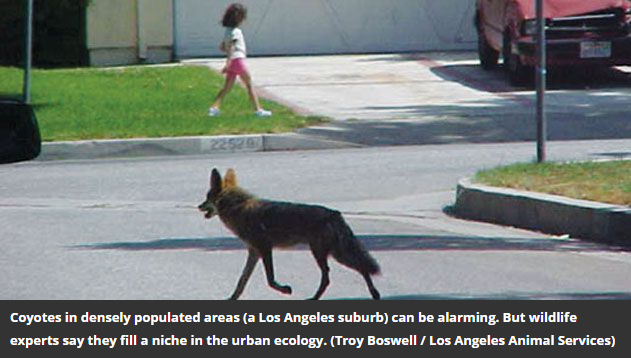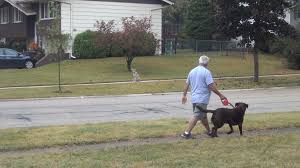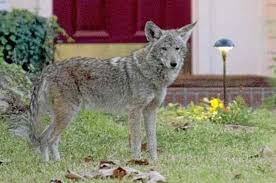
Parsing Predator Propaganda
By Jim Beers
The following news article from the EAST BAY TIMES was parroted by the authors from a California Department of Fish and Wildlife bureaucrat (note the Imprimatur at the end of the article) that propagandizes the general public by justifying the unjustifiable wildlife policies of this infamous Urban Elite State where the protection of dangerous wild animals increases as the value of American citizens’ lives and property is correspondingly being devalued. I seldom see the juxtaposition of the unspoken reversal of human and wild animal value described as well as in this propaganda piece.
Therefore, I have taken the liberty of inserting comments and observations (in red) that will, hopefully, give the reader things to ponder, and not only about these erstwhile and formerly wild coyotes.
Bold, brazen coyotes spread fear in Southern California as they seek fast, easy food
By David Downey and Steve Scauzillo
Rainy winter and increase in prey may account for increased activity of opportunistic eaters 1. NOTE: Have you ever heard of wolves or cougars or grizzly bears described as “opportunistic eaters”? Could that be because these three predators have been propagandized by bureaucrats and current “biologists” as only being of danger to humans that “did not behave or react according to some contrived nonsense” like “puffing up”? In the meantime, these same politicians and their servile bureaucrats and academics continue to write and enforce Draconian regulations and laws protecting these three predators, banning guns and ammunition, and vilifying anyone that speaks out about how wolves, cougars and grizzly bears do not belong in settled landscapes. That is why coyotes can be described as spreading “fear” while wolves, cougars and grizzly bears are environmental triumphs of restoration of “native” species evoking only cheers as they are likewise forcibly spread by criminalizing the protection of human life and property.

Linda DeVore, 65, with her Shitzu, Teddy, who is recovering after being attacked by a coyote in her backyard at the Menifee trailer park in Sun City on Thursday, June 27, 2019. Mobile home park residents said coyotes regularly roam the trailer park, day and night. 2. Could it be because they are protected and the residents’ presence provides food and cover? If Native Americans and early American explorers and settlers were so naïve as to wonder about such phenomenon and not understand that reducing and excluding their presence continually is not the answer… they would have gone extinct and our current socialist society of cowed children ruled by a tyranny that they deny exists, would not be here in such a pitiful state. (Photo by Watchara Phomicinda, The Press-Enterprise/SCNG)
Linda DeVore nearly lost Teddy to a coyote two weeks ago.
A Shih Tzu dog, Teddy had just gone out the doggy door to do his business the morning of Monday, June 17. Moments later, DeVore, 65, walked outside her Menifee mobile home to find Teddy in the clutches of a coyote the size of a German shepherd. 3. If a 60 -70 (?) lb. coyote can strike such fear and carry off a dog to eat: why are we able to be bamboozled into being trained to accept packs of 100+ lb. wolves or 200+ lb. cougars or 800 – 1700 lb. grizzly bears in our midst where kids, old folks and other vulnerable humans live, work and raise their families?
“When he heard me at the back door he dropped Ted,” she said. But not before taking a huge bite out of the dog’s throat. 4. If a dog can have its throat bitten that quick, what of a child or some old lady walking to the rural mailbox? At what cost; three kids, four old ladies, two teenage deer archery hunters, etc.; will we begin to question the predator bill of goods being forcibly imposed on rural Americans by politicians seeking votes; bureaucrats seeking power and bonuses; academics seeking tenure and fame; and soulless non-government organizations seeking donations and publicity?
The attack was the latest on a small pet at the 265-space Hillside Mobile Home Estates. Teddy survived. Other residents’ pets — like Mike Cooper’s orange tabby cat Meow and Pomeranian dog Sassie — did not.
And it was among the latest coyote sightings and attacks across the Inland Empire, where residents and others say the wild animals’ activity is on the rise. 5. What do “residents and others” know? They are not “experts” in either the law or estimating wild populations. They should just sit down and leave this to the “experts” that know “what’s best.”
“The coyotes are getting ridiculous,” said Hillside resident Donna Gardner, 67. 6. Really? The coyotes are simply being coyotes. No mystery here. It is called “habituation” or “boldness.” When they (coyotes, wolves, cougars, grizzly bears, et al) are protected and become dense locally and more numerous over wide areas; they frequent more often human habitation looking for food and whatever. That, like a free-roaming dog that may bite a kid or kill one to eat it should be of no surprise, no matter what the “experts” tell the teachers to tell the kids. “They live in the trailer park. They have decided that this is their home,” she said. “But it gets annoying when they come into your yard and eat your animals.” 7. Am I expected to believe that some 67 year-old lady in a trailer park with a pet that is probably the height of her life, only finds coyotes that “come into your yard and eat your animals”, “annoying”? The Cal F&W bureaucrat or tinker belle author that heard that is going too far or needs his/her ears cleaned out. Even I, with my years without a dog (many of whom I had great affection for) would find that much more than “annoying”.
These last two weeks have been busy as well for Redlands coyote trapper Lowell Miller in San Bernardino County.
“I just removed a trapped coyote last night at a Target distribution center in Fontana,” Miller, owner of Lowell’s Wildlife Removal, said Friday, June 28. “And I had another one this morning.”
Miller said he caught two other young coyotes recently at the Sierra Lakes Golf Club in Fontana, bringing to 10 the total so far this year.
But are more coyotes really out there? That’s not an easy question to answer. 8. Really? The “experts” can tell exactly (pups, packs, odd numbers and all) the numbers of wolves, cougars and grizzly bears when they go into court as the only “real” experts: why not coyotes? Because no one goes to court over coyotes, truth be known. When rural bumpkins complain about wolves, cougars and grizzlies killing livestock, game animals and pets in increasing numbers, some government bureaucrat complete with computer and a briefcase full of charts and numbers testifies in a New York second about how these predator populations are “stable” or “declining” and therefore the rubes are imagining things or failing to provide proper livestock or pet protection. When it is suggested that the predators be permanently reduced in numbers by hunting and trapping; they spring forth with “studies” claiming a paucity of “Alpha” males or misuse (by humans) of the Predator’s habitat.
Some experts suggest the rainy winters of the past few years have upped the number of fruit dropping from trees, as well as the population of gophers, snakes and rabbits, primary coyote food sources. 9. In Minnesota, we blamed the disappearance of moose and moose hunting while wolf numbers soared, on “climate change.” Old ladies killed in Idaho and Wisconsin were killed by unknown animals. Horseback riders, campers, hikers and bike riders killed by grizzlies were blamed for not behaving properly. “Some experts” equals “no experts”. “Some experts” is a synonym for pandering bureaucrats and greedy academicians.

Meanwhile, litters of canis latrans — listed in a category given to dogs, wolves and foxes — can reach as many as 10 to 13 pups, scientists say.
“If it has been a good year in terms of rain and vegetation, they will have larger litters,” said Ken Pellman, spokesman for the Los Angeles County Agricultural Commissioner’s Office, which handles coyote issues in unincorporated county areas and for cities under contract. “With all the rains, you might see more of them.” 10. If we are to be held hostage to weather as to whether or not a plague of wild animals will spring up in our midst; the only answer may be to throw a virgin into a volcano or erect a new temple to Gaia. Clearly government has no answer and if recent history teaches us anything. Politicians, bureaucrats, academicians and environmental/animal rights’ ideologues only make things much worse.
The office traps a coyote only if it is a threat to a human, (11. Why only “if it is a threat to a human”? Why not to eliminate or reduce pet loss and injury? Why not to make Trailer Parks safer? Why not to reduce animal complaint costs to government?) fhe said. Trapping is extremely difficult because coyotes are smart enough to avoid them. When the office does trap a coyote, it is euthanized. State law prohibits relocating coyotes because it may transfer disease and often leave the coyote prey to mountain lions or starvation, Pellman said. 12. This is priceless. Cal F&W, like many Democrat-run States and the federal government relocates (midnight releases along rural roads, remote locations, etc.) cougars, wolves, and grizzly bears while telling the general public they were taken to a “wilderness location” to lead a “happy life.” Even better is the canard, “because it may transfer disease.” When is the last time you heard some government bureaucrat or some veterinarian or other “expert” admit the wolves (coyotes on steroids), cougars or grizzly bears “transfer disease?” Never, has been my experience, indeed they (except for the veterinarians) either scream or run. When I mention that in a talk, the bureaucrats and veterinarians either squawk that I have insufficient credentials to say that, or they go into another room to commit Hari-kari or, as one state Director did, to run out into the parking lot and speed off in his government car. The reason; coyotes are merely nasty while wolves, cougars and grizzlies are to be worshipped as some sort of penance for European settlement of North America and our current society built on capitalism, Constitutional freedom, and hard work. Finally, if a translocated coyote can’t find any food you can bet your bippy he will head straight for the nearest food source “Hayaku” (Japanese for “fast.”) Starving is not found in the coyote dictionary.
Biologist Justin Brown, of the National Park Service, has been studying urban coyotes in Southern California for more than five years. He wouldn’t say the urban coyote population is increasing exactly. 13. Justin would have been a hoot on the Johnny Carson Show. A “five year” expert and the best he can say is he won’t say “the urban coyote population is increasing exactly.” While Justin would not be a good “expert” in court (too tentative) regarding predators, he has future Regional Office Director tattooed across his forehead. You cannot imagine what reading this sort of tripe over the past 20 years since my retirement is like for me. Pardon me, I must go gag myself with a spoon.
More likely, they are establishing themselves in certain areas as territorial statements, Brown said. One pack may set up a boundary against another and dig in, protecting their territory. Of course, the neighborhoods they choose are rich in food resources, such as fruit trees, rabbits, gophers, outdoor pet food and yes, sometimes domestic cats and small dogs.
 A two-year study released in March by the National Park Service of 3,200 samples of coyote scat found human food and pet food made up 26% of their diet, as did ornamental fruit. Rabbits made up 18% and domestic cats, 20%. Gophers and insects made up 28% combined.
A two-year study released in March by the National Park Service of 3,200 samples of coyote scat found human food and pet food made up 26% of their diet, as did ornamental fruit. Rabbits made up 18% and domestic cats, 20%. Gophers and insects made up 28% combined.
Early studies showed domestic cats in lower percentages. Dogs were not found in the diet of coyotes in either study. 14. The preceding four paragraphs were probably cribbed from a BBC nature program and are meant to give the article a touch of “nature” for the general reader that got this far. They mean nothing outside what is to be done which is conveniently AWOL from this article.
Brown called the population in Southern California “stable,” not shrinking, not growing. “Coyotes are pretty much widespread throughout L.A.,” he said, downplaying reports of more in particular areas as anecdotal.
Brian Cronin, chief of animal care and control for the San Bernardino County Department of Public Health, said coyote trappings for the 12-month period ending June 30 were on track to exceed the previous year’s total, but well off the pace of two years ago.
The agency fielded 250 wildlife-complaint calls in its 2016-17 fiscal year, more than 90 percent of them involving coyotes, Cronin said. He said those calls led to 175 coyotes being trapped and euthanized. 15. Since there is no reliable or even ballpark coyote picture in the article, the preceding three paragraphs are meaningless measures of everything except bureaucrats’ time sheets.
 He attributed the large number of trappings that year to the August 2016 Blue Cut fire, which torched coyote territory and food supply and forced many animals to look for new homes. 16. So why not blame forest fires for coyotes? The general public will believe it. Anything to avoid even mentioning of man-made causes of the fires. If we blamed the lack of plant management on public and private California lands or the Wilderness Act and other human concoctions like the ESA for forest fires, then the coyote problem would have to be blamed on something else since WE couldn’t be causing these problems while claiming to be “Green”.
He attributed the large number of trappings that year to the August 2016 Blue Cut fire, which torched coyote territory and food supply and forced many animals to look for new homes. 16. So why not blame forest fires for coyotes? The general public will believe it. Anything to avoid even mentioning of man-made causes of the fires. If we blamed the lack of plant management on public and private California lands or the Wilderness Act and other human concoctions like the ESA for forest fires, then the coyote problem would have to be blamed on something else since WE couldn’t be causing these problems while claiming to be “Green”.
During the 2017-18 fiscal year, the agency received 244 wildlife calls, but trapped fewer coyotes — 96.
Through April — with two months to go in the 2018-19 fiscal year — there were 204 calls and 95 coyotes had been trapped, he said.
His agency oversees unincorporated areas of San Bernardino County and Highland, Yucaipa and Big Bear Lake.
Cronin said there tends to be more sightings this time of the year.
“They are looking for food, especially in the summer months, when food and water may be scarce,” he said.
Miller, the trapper, said it’s also common to see coyotes now because pups born earlier in the year are growing up and roaming around.
“I don’t see anything out of the ordinary this year,” Miller added. 17. That is because you are protecting and prioritizing coyotes and not the humans that pay your salary.
Still, the residents of Hillside Mobile Home Park would argue otherwise.
And some activities didn’t exactly seem ordinary the other day.
For example, 60-year-old Susan Thomas was walking her 5 pound, 4-ounce Chihuahua-Terrier mix Macy May — on a leash — in her backyard.
“I’m afraid to leave her,” Thomas said, as she kept a close eye on a 6-foot fence next to a field.
There are far fewer cats in the park these days, neighbors say, probably because some have become coyote meals.
“The cats around here? They’re extinct,” Ed Peralta said.
As cats have moved out, coyotes have moved in.
Diane Lembeck said she found five pups and a mother coyote living under her trailer in spring 2018.
“I started hearing a lot of noises and I thought it was the plumbing,” Lembeck said. “The next thing I knew, they were playing out in the front yard.”
 Lembeck said she spent many sleepless nights until they were trapped. 18. What does she know? I get so tired of their whining and complaining. Why don’t they just move into a government apartment if they “don’t want to live with nature?” I apologize, Bureaucrats Anonymous tells me to not get excited, it can cause me to sometimes revert to old habits.
Lembeck said she spent many sleepless nights until they were trapped. 18. What does she know? I get so tired of their whining and complaining. Why don’t they just move into a government apartment if they “don’t want to live with nature?” I apologize, Bureaucrats Anonymous tells me to not get excited, it can cause me to sometimes revert to old habits.
Peralta has been asked several times to trap coyotes in the park. For bait, he said, he uses “a piece of chicken, can of tuna, whatever I’ve got.”
Gardner added that coyotes stroll the walkways and even greet people at the mailbox.
“It’s only a matter of time before they attack one of us,” Gardner said. 19. Truer words were never spoken but who cares? Who is doing anything about it? What must be done?
It was bad enough, she said, that she found a coyote carcass a while back. That had to have been the work of a cougar, Gardner said. “And I don’t mean one of the old women here. I mean an actual cougar,” she said.
Experts say coyotes are known for being bold, smart, crafty and opportunistic. 20. Just like wolves, cougars and grizzly bears. That is why we call Mexican human smugglers on our Southern Border, coyotes.
“They’re going for the easy meals,” Miller said. “They don’t want to work any harder than they have to. I think that’s why they have become bolder and more brazen in urban areas.” 21. How profound. So what is government doing about it?
And, so, people need to keep small pets — and their food — inside, experts say. (as Ronald Reagan said to President Carter in a debate, “There you go again!”)
“The goal is to make sure that your environment isn’t attracting coyotes,” Cronin said. 22. Duh! Good luck with that. Coyotes, cougars and grizzly bears have lived and propagated from the Artic to the Equator; in tundra, temperate woodlands and prairies to jungles and deserts. Wherever they can find food and nothing kills more of them than their propagation rate provides, they are good to go. It is neither rocket nor in this case biological “science.”
Carlos Orellana, assistant manager of the Menifee mobile home park, said he’s trying to do that. He never lets his dog go outside without him.
“And I carry a big stick,” Orellana said. 23. Sir, you and all your neighbors are living more and more like unarmed African natives forced to live with crocs, hippos, leopards et al without recourse or Indians forced to live with tigers, wolves and cobras. Do you never ask yourself, “Why?” Do you never demand a people-friendly environment? Whose fault is that?
PREVENTING COYOTE ATTACKS
Never feed or attempt to tame coyotes. The result may be deadly conflicts with pets or livestock, or serious injuries to small children.
Do not leave small children or pets outside unattended.
Install motion-sensitive lighting around the house.
Trim ground-level shrubbery to reduce hiding places.
Be aware that coyotes are more active in the spring, when feeding and protecting their young.
If followed by a coyote, make loud noises. If this fails, throw rocks in the animal’s direction.
If a coyote attacks a person, immediately contact the nearest Department of Fish and Wildlife or law enforcement office. 24. These nostrum are so sad. Imagine if an African government expanded the range and protection of leopards that killed livestock and people in the villages, and crocs that killed women and kids along waterways, and then issued advice like the above. Substitute “wolf” or “tiger” for “coyote” above for use in India. I submit that the ONLY winners are the government bureaucrats mentioned in the last bullet. What with the paperwork and the “investigation”, a slick bureaucrat might be able to claim he “needs” helpers or, at the least, get some overtime out of it BECAUSE IF THINGS JUST KEEP GOING LIKE THEY ARE, THIS WILL BE A NEVER-ENDING BUREAUCRATIC CAREER FOR A PROBLEM THAT WILL NEVER BE RESOLVED AND FOR WHICH THERE WILL NEVER BE “ENOUGH” MONEY. PEOPLE WILL DIE AND SUFFER INJURIES. PRIVATE PROPERTY WILL CONTINUE TO BE DESTROYED. RURAL COMMUNITIES AND THEIR ECONOMIES WILL AT BEST STAGNATE AND AT WORST DISSOLVE. LIVESTOCK WILL DWINDLE AND GAME WILL DISAPPEAR. AND IRONICALLY THE “LOVE”, “PRIORITY” AND “CONCERN” SHOWN THESE PREDATORS VIA GOVERNMENT FORCE WILL TURN THESE ONCE-APPRECIATED WILD ANIMALS INTO HABITUATED CROSS BREEDS (COYOTE x DOG x WOLF =?) BACK INTO THE DEMONS OF OLD THAT WERE ONCE EXTERMINATED AT GREATER EXPENSE AND EFFORT THAN IT WILL TAKE WHEN THE PEOPLE HAVE HAD ENOUGH THE NEXT TIME AROUND.
Source: California Department of Fish and Wildlife
Jim Beers
2 July 2019
If you found this worthwhile, please share it with others. Thanks.
Jim Beers is a retired US Fish & Wildlife Service Wildlife Biologist, Special Agent, Refuge Manager, Wetlands Biologist, and Congressional Fellow. He was stationed in North Dakota, Minnesota, Nebraska, New York City, and Washington DC. He also served as a US Navy Line Officer in the western Pacific and on Adak, Alaska in the Aleutian Islands. He has worked for the Utah Fish & Game, Minneapolis Police Department, and as a Security Supervisor in Washington, DC. He testified three times before Congress; twice regarding the theft by the US Fish & Wildlife Service of $45 to 60 Million from State fish and wildlife funds and once in opposition to expanding Federal Invasive Species authority. He resides in Eagan, Minnesota with his wife of many decades.
Jim Beers is available to speak or for consulting.
You can receive future articles by sending a request with your e-mail address to: jimbeers7@comcast.net